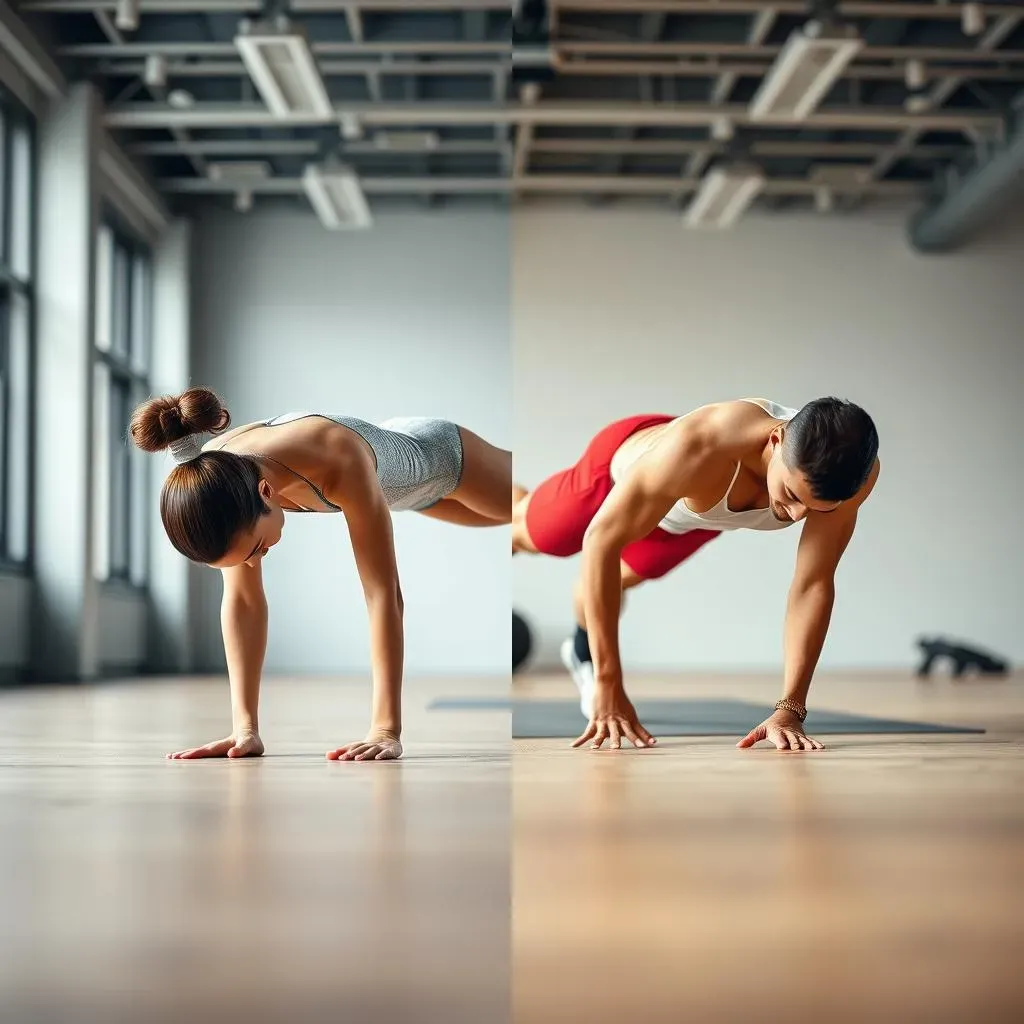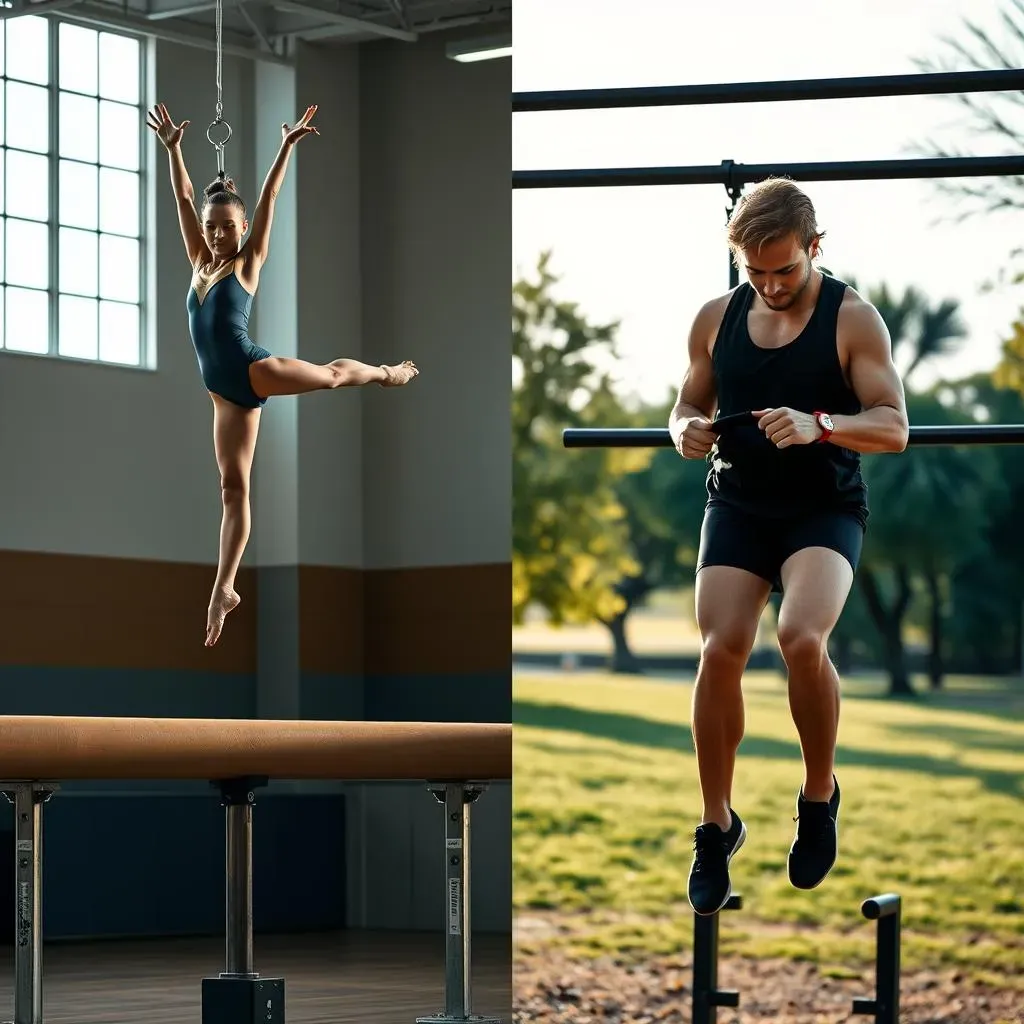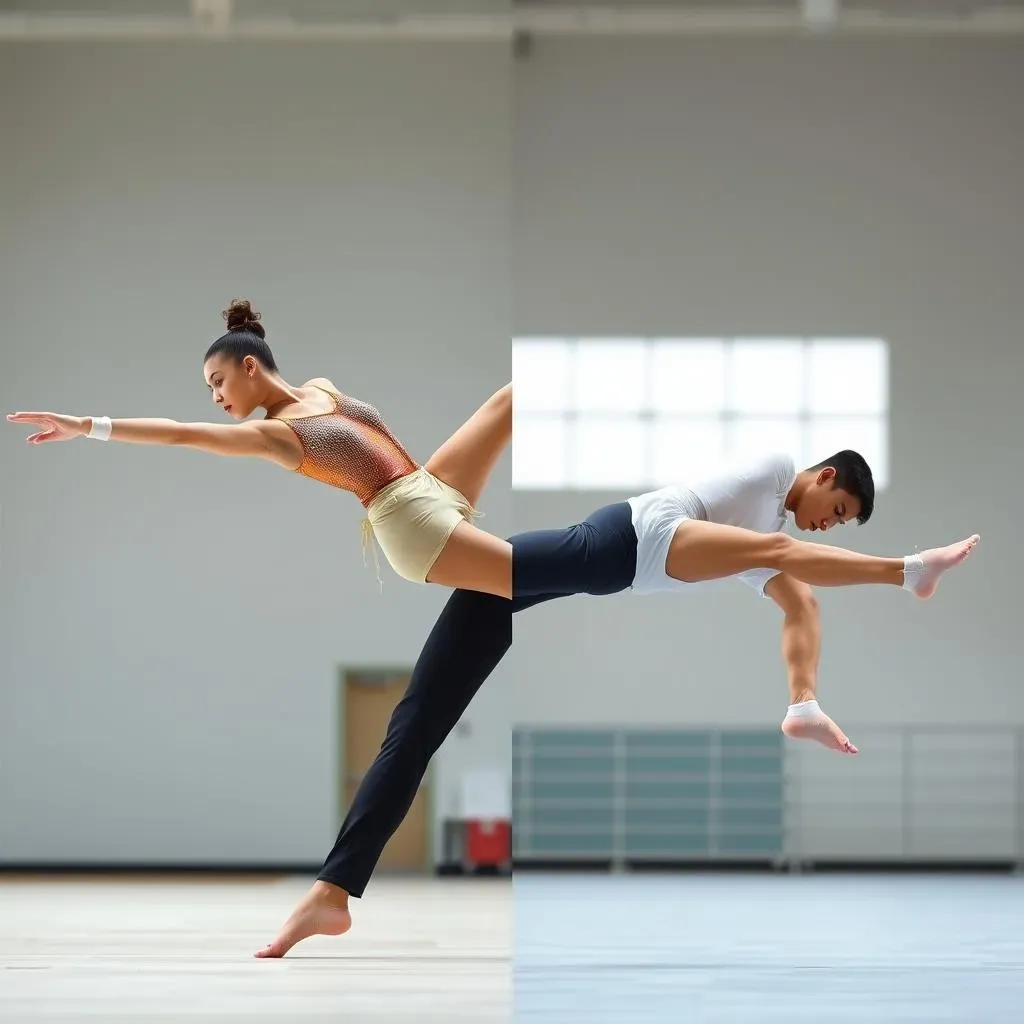Table of Contents
When it comes to physical fitness and athleticism, two disciplines often come to mind: gymnastics and calisthenics. While both share some similarities, they also have distinct differences that set them apart. In this article, we'll delve into the world of gymnastics vs calisthenics, exploring their histories, philosophies, and practices. We'll examine the similarities between the two, such as their use of bodyweight exercises and emphasis on strength, flexibility, and coordination. However, we'll also discuss the key differences, including the equipment, environment, and competitive aspects that distinguish gymnastics from calisthenics. Whether you're a seasoned athlete or just starting your fitness journey, understanding the nuances of gymnastics vs calisthenics will help you decide which discipline is best suited to your goals and preferences. So, let's dive into the world of gymnastics vs calisthenics and discover the unique characteristics of each.
Gymnastics vs Calisthenics: Introduction to Both Disciplines

Gymnastics vs Calisthenics: Introduction to Both Disciplines
Introduction to Gymnastics
Gymnastics is a highly disciplined and competitive sport that requires a great deal of strength, flexibility, and coordination. It involves various apparatuses such as the floor, beam, vault, and bars, each requiring specific skills and techniques. Gymnastics has a rich history, dating back to ancient civilizations, and has evolved over time to become the Olympic sport we know today. With its emphasis on precision, control, and artistry, gymnastics is a popular activity for both recreational and competitive athletes.
Gymnastics training typically takes place in a controlled environment, such as a gym, with specialized equipment and experienced coaches. This structured approach allows gymnasts to develop their skills in a safe and progressive manner. Whether you're interested in artistic gymnastics, rhythmic gymnastics, or other disciplines, gymnastics offers a unique and challenging way to improve your physical fitness and mental toughness.
Gymnastics Discipline | Description | Examples |
|---|---|---|
Artistic Gymnastics | Short routines on various apparatuses | Floor exercise, still rings, balance beam |
Rhythmic Gymnastics | Combines dance and gymnastics with apparatuses | Ribbon, ball, hoop |
Introduction to Calisthenics
Calisthenics, on the other hand, is a form of exercise that uses bodyweight as resistance to build strength, flexibility, and coordination. It has gained popularity in recent years due to its accessibility and versatility. Calisthenics can be practiced anywhere, from outdoor parks to indoor gyms, with minimal equipment. This discipline emphasizes functional movement and creative expression, allowing practitioners to develop their own unique style and routines.
Calisthenics has its roots in street workout culture, where individuals would gather in public spaces to train and showcase their skills. Today, calisthenics has evolved into a global community, with athletes sharing their knowledge and inspiring others through social media and workshops. Whether you're a beginner or an advanced practitioner, calisthenics offers a fun and challenging way to improve your overall fitness and well-being.
- Bodyweight exercises: push-ups, pull-ups, squats
- Dynamic movements: muscle-ups, bar spins, human flag
- Freestyle routines: combining strength and dance
Similarities and Differences
While gymnastics and calisthenics share some similarities, such as their use of bodyweight exercises and emphasis on strength and flexibility, they also have distinct differences. Gymnastics is a highly structured and competitive sport, whereas calisthenics is a more free-form and expressive discipline. Understanding these similarities and differences is essential for choosing the right path for your fitness journey.
In the following sections, we'll delve deeper into the similarities and differences between gymnastics and calisthenics, exploring their environments, equipment, competitions, and judging criteria. By the end of this article, you'll have a comprehensive understanding of both disciplines and be able to decide which one aligns best with your goals and preferences.
Similarities Between Gymnastics and Calisthenics

Similarities Between Gymnastics and Calisthenics
Despite their differences, gymnastics and calisthenics share a common bond - both disciplines rely heavily on bodyweight exercises to build strength, flexibility, and coordination. In gymnastics, bodyweight exercises are used to develop fundamental skills such as handstands, bridges, and walkovers. Similarly, in calisthenics, bodyweight exercises like push-ups, pull-ups, and squats are staples of the discipline. Both gymnastics and calisthenics athletes use these exercises to improve their overall fitness and prepare their bodies for more advanced movements.
Another similarity between gymnastics and calisthenics is the emphasis on proper form and technique. In gymnastics, precise technique is crucial for executing skills safely and effectively. Similarly, in calisthenics, athletes focus on mastering proper form to ensure they're getting the most out of their workouts and minimizing the risk of injury. This attention to detail and commitment to proper technique is a hallmark of both disciplines.
Exercise | Gymnastics Variation | Calisthenics Variation |
|---|---|---|
Push-up | Planche push-up | Clapping push-up |
Pull-up | L-sit pull-up | Muscle-up |
Squat | Overhead squat | Pistol squat |
Both gymnastics and calisthenics also place a strong emphasis on flexibility and mobility. Gymnasts use flexibility exercises like splits and bridges to improve their range of motion, while calisthenics athletes incorporate movements like leg swings and arm circles to enhance their flexibility. This focus on flexibility allows athletes in both disciplines to perform complex movements with greater ease and precision.
- Flexibility exercises: splits, bridges, leg swings
- Mobility drills: arm circles, leg swings, hip openers
- Dynamic stretching: high knees, butt kicks, leg swings
Finally, both gymnastics and calisthenics require a great deal of mental toughness and discipline. Gymnasts must focus and concentrate to execute their routines flawlessly, while calisthenics athletes need to push themselves to new heights, often attempting moves that challenge their limits. This mental aspect is just as important as the physical, as it allows athletes to overcome obstacles and reach their full potential.
While gymnastics and calisthenics have their differences, their similarities are undeniable. By recognizing these shared characteristics, athletes from both disciplines can learn from and appreciate each other's approaches, ultimately becoming better athletes in the process.
Gymnastics vs Calisthenics: Key Differences in Environment and Equipment

Gymnastics vs Calisthenics: Key Differences in Environment and Equipment
Environment: Gymnastics vs Calisthenics
Gymnastics and calisthenics differ significantly in their environments. Gymnastics is typically practiced in a controlled, indoor setting such as a gymnasium. This environment is equipped with specialized apparatuses like the floor, beam, vault, and bars, which are designed to provide a safe and structured space for athletes to train. The indoor setting also allows for climate control, ensuring that athletes can train comfortably regardless of the weather.
In contrast, calisthenics is often practiced outdoors in parks, playgrounds, or other public spaces. This outdoor environment provides calisthenics athletes with the freedom to train in a more natural setting, using equipment like pull-up bars, parallel bars, and benches. The outdoor setting also allows for more creativity and improvisation, as athletes can incorporate various obstacles and features into their workouts.
Discipline | Typical Environment | Equipment |
|---|---|---|
Gymnastics | Indoor gymnasium | Specialized apparatuses (floor, beam, vault, bars) |
Calisthenics | Outdoor public spaces | Bodyweight equipment (pull-up bars, parallel bars, benches) |
Equipment: Gymnastics vs Calisthenics
The equipment used in gymnastics and calisthenics is another key differentiator between the two disciplines. Gymnastics requires a range of specialized equipment, including the floor, balance beam, vault, and uneven bars. These apparatuses are designed to test gymnasts' strength, flexibility, and coordination, and are typically made of wood, metal, or other materials that provide the necessary support and stability.
Calisthenics, on the other hand, often utilizes minimal equipment, with athletes relying on their own body weight as resistance. When equipment is used, it's often in the form of bars, rings, or other basic apparatuses that can be found in outdoor settings. This minimal equipment approach allows calisthenics athletes to focus on functional movements and creativity, rather than relying on specialized gear.
- Gymnastics equipment: floor, beam, vault, bars
- Calisthenics equipment: pull-up bars, parallel bars, benches
- Bodyweight exercises: push-ups, pull-ups, squats, lunges
Gymnastics vs Calisthenics: Competitions and Judging Criteria

Gymnastics vs Calisthenics: Competitions and Judging Criteria
Competitions in Gymnastics
Gymnastics competitions are highly structured and formal events, often taking place at the local, national, or international level. These competitions are judged on specific criteria, including technique, execution, and overall performance. Gymnasts are required to perform predetermined routines on various apparatuses, and their scores are based on how well they execute these routines. The competitive nature of gymnastics demands a high level of precision, consistency, and artistry, making it a challenging and rewarding discipline for athletes.
In contrast, calisthenics competitions are more relaxed and informal, often taking place in outdoor settings like parks or beaches. These events focus on creativity, difficulty, and crowd-pleasing elements, with judges scoring athletes on their unique moves, technique, and overall performance. Calisthenics competitions prioritize self-expression and improvisation, allowing athletes to showcase their individual styles and push the boundaries of what's possible with bodyweight exercises.
Discipline | Competition Style | Judging Criteria |
|---|---|---|
Gymnastics | Formal, structured routines | Technique, execution, overall performance |
Calisthenics | Informal, creative routines | Creativity, difficulty, crowd appeal |
Judging Criteria: Gymnastics vs Calisthenics
The judging criteria for gymnastics and calisthenics competitions differ significantly. Gymnastics judges focus on the technical aspects of each routine, evaluating factors like proper form, execution, and overall performance. In calisthenics, judges consider a broader range of factors, including creativity, difficulty, and entertainment value. This subjective approach to judging allows calisthenics athletes to express themselves freely and showcase their unique skills.
While gymnastics competitions prioritize perfection and consistency, calisthenics competitions celebrate individuality and creativity. This fundamental difference in judging criteria reflects the distinct philosophies of each discipline, with gymnastics emphasizing technical precision and calisthenics emphasizing self-expression and innovation.
- Gymnastics judging criteria: technique, execution, overall performance
- Calisthenics judging criteria: creativity, difficulty, crowd appeal
- Subjective vs objective judging: calisthenics is more subjective, gymnastics more objective
Ultimately, the competitions and judging criteria in gymnastics and calisthenics reflect the unique values and goals of each discipline. By understanding these differences, athletes can choose the path that best aligns with their personal preferences and goals, whether that's the precision and structure of gymnastics or the creativity and freedom of calisthenics.
Gymnastics vs Calisthenics: Which One is Right for You?

Gymnastics vs Calisthenics: Which One is Right for You?
Understanding Your Goals and Preferences
When deciding between gymnastics and calisthenics, it's essential to consider your personal goals and preferences. If you're looking for a highly structured and competitive environment, gymnastics might be the better choice. Gymnastics provides a clear progression of skills, allowing you to track your progress and strive for excellence in a specific discipline. However, if you prefer a more relaxed and creative approach to fitness, calisthenics could be the way to go. Calisthenics offers the freedom to experiment with different movements and routines, making it an excellent choice for those who value self-expression and variety in their workouts.
Another crucial factor to consider is your current fitness level and any physical limitations you may have. Gymnastics can be a high-impact activity, requiring a certain level of strength, flexibility, and coordination. If you're just starting out or have mobility issues, you may find calisthenics more accessible, as it offers a range of modifications and progressions to suit different fitness levels. On the other hand, if you're looking for a challenge and enjoy pushing yourself to new heights, gymnastics might be more appealing.
Discipline | Goals and Preferences | Fitness Level |
|---|---|---|
Gymnastics | Structured, competitive, perfectionistic | Advanced, high-impact |
Calisthenics | Relaxed, creative, self-expressive | Beginner-friendly, adaptable |
Evaluating Your Lifestyle and Schedule
Your lifestyle and schedule should also play a role in your decision. If you have a busy schedule or prefer to train at home, calisthenics might be more convenient. Calisthenics can be practiced anywhere, without the need for specialized equipment or a gym membership. This makes it an excellent choice for those who value flexibility and want to incorporate fitness into their daily routine. Gymnastics, on the other hand, often requires a significant time commitment, as you'll need to attend classes or training sessions at a gym. However, if you're willing to dedicate the time and enjoy the social aspect of training with others, gymnastics can be a rewarding and motivating experience.
Additionally, consider your budget and the cost of equipment or classes. Gymnastics typically requires a significant investment in classes, equipment, and attire. Calisthenics, while potentially requiring some equipment like pull-up bars or rings, is generally more budget-friendly and accessible. If you're on a tight budget or prefer a low-cost fitness option, calisthenics might be the more economical choice.
- Gymnastics: Classes, equipment, attire
- Calisthenics: Minimal equipment, outdoor training
- Budget-friendly: Calisthenics
- Social aspect: Gymnastics
Making Your Decision
Ultimately, the decision between gymnastics and calisthenics comes down to your personal preferences, goals, and circumstances. Both disciplines offer unique benefits and challenges, and it's essential to choose the one that aligns best with your lifestyle and aspirations. If you value structure, precision, and competition, gymnastics might be the better fit. However, if you prefer creativity, self-expression, and flexibility, calisthenics could be the way to go.
Remember, there's no right or wrong choice – both gymnastics and calisthenics can be incredibly rewarding and beneficial for your physical and mental well-being. By considering your goals, fitness level, lifestyle, and budget, you'll be able to make an informed decision and embark on a fitness journey that suits your unique needs and preferences.
Conclusion: Embracing the Unique Benefits of Gymnastics and Calisthenics
In conclusion, the debate between gymnastics vs calisthenics ultimately comes down to personal preference, goals, and values. Both disciplines offer unique benefits, whether it's the structure and precision of gymnastics or the creativity and freedom of calisthenics. By understanding the similarities and differences between these two disciplines, individuals can make informed decisions about which path to pursue. Whether you're drawn to the competitive aspect of gymnastics or the self-expressive nature of calisthenics, both offer a journey of physical growth, mental toughness, and self-discovery. So, explore both worlds, find what resonates with you, and embark on a fitness journey that combines the best of gymnastics and calisthenics to achieve your full potential.
